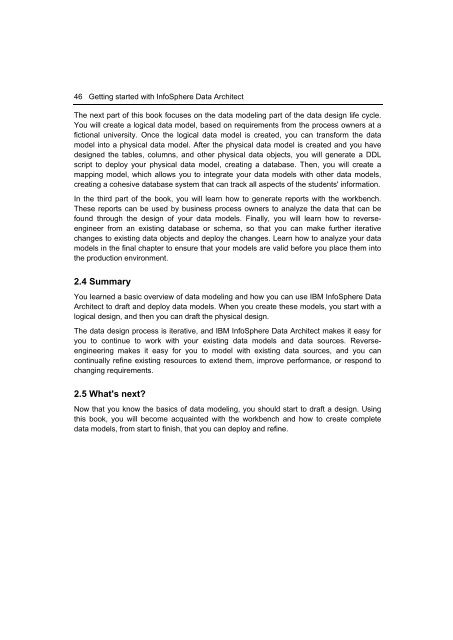Getting Started with InfoSphere Data Architect
You also want an ePaper? Increase the reach of your titles
YUMPU automatically turns print PDFs into web optimized ePapers that Google loves.
46 <strong>Getting</strong> started <strong>with</strong> <strong>InfoSphere</strong> <strong>Data</strong> <strong>Architect</strong><br />
The next part of this book focuses on the data modeling part of the data design life cycle.<br />
You will create a logical data model, based on requirements from the process owners at a<br />
fictional university. Once the logical data model is created, you can transform the data<br />
model into a physical data model. After the physical data model is created and you have<br />
designed the tables, columns, and other physical data objects, you will generate a DDL<br />
script to deploy your physical data model, creating a database. Then, you will create a<br />
mapping model, which allows you to integrate your data models <strong>with</strong> other data models,<br />
creating a cohesive database system that can track all aspects of the students' information.<br />
In the third part of the book, you will learn how to generate reports <strong>with</strong> the workbench.<br />
These reports can be used by business process owners to analyze the data that can be<br />
found through the design of your data models. Finally, you will learn how to reverseengineer<br />
from an existing database or schema, so that you can make further iterative<br />
changes to existing data objects and deploy the changes. Learn how to analyze your data<br />
models in the final chapter to ensure that your models are valid before you place them into<br />
the production environment.<br />
2.4 Summary<br />
You learned a basic overview of data modeling and how you can use IBM <strong>InfoSphere</strong> <strong>Data</strong><br />
<strong>Architect</strong> to draft and deploy data models. When you create these models, you start <strong>with</strong> a<br />
logical design, and then you can draft the physical design.<br />
The data design process is iterative, and IBM <strong>InfoSphere</strong> <strong>Data</strong> <strong>Architect</strong> makes it easy for<br />
you to continue to work <strong>with</strong> your existing data models and data sources. Reverseengineering<br />
makes it easy for you to model <strong>with</strong> existing data sources, and you can<br />
continually refine existing resources to extend them, improve performance, or respond to<br />
changing requirements.<br />
2.5 What's next?<br />
Now that you know the basics of data modeling, you should start to draft a design. Using<br />
this book, you will become acquainted <strong>with</strong> the workbench and how to create complete<br />
data models, from start to finish, that you can deploy and refine.

















